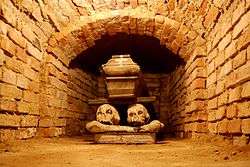Wola Gułowska
Wola Gułowska [ˈvɔla ɡuˈwɔfska] is a village in the administrative district of Gmina Adamów, within Łuków County, Lublin Voivodeship, in eastern Poland. It lies approximately 7 kilometres (4 mi) south-west of Adamów, 27 km (17 mi) south-west of Łuków, and 57 km (35 mi) north-west of the regional capital Lublin.[1]
Wola Gułowska | |
|---|---|
Village | |
 Coffin in a brick-lined crypt under the church in Wola Gułowska | |
 Wola Gułowska | |
| Coordinates: 51°42′1″N 22°12′41″E | |
| Country | |
| Voivodeship | Lublin |
| County | Łuków |
| Gmina | Adamów |
| Population | |
| • Total | 360 |
The village has a population of 360.
History
Wola Gułowska is located on the rzeką Czarną (Black River), a small tributary of the Tyśmienica. It is located on the edge of the Plateau Żelechowskiej near the Łukowski plains. The terrain points to the rzeźbie terenu (Black Valley) and towering above the village the church of the Carmelite monastery dominates.
The oldest references to Wola Gułowska is from the years 1508 and 1545. In 1633, Ludwik Krasiński, heir to the local property, decided to found the Carmelite Monastery and build a new church in place of the old wooden chapel. The construction of the church was completed and consecrated in 1782. The church is famous for its miraculous image of the Virgin Mary, recognised in 1982 by the Archbishop Józef Glemp, and a copy of the image of Madonna.[2]
Over 3 to 5 October 1939 Polish soldiers fought against German in the Wola Gułowska by the cemetery (the cemetery was taken by Poles). During the fighting near Wola Gulowska, the Poles and the German paratroopers also fought near local airfield. The fighting near Wola Gulowska was one of the smaller battles fought during the Battle of Kock. The Poles were defeated due to depletion of ammunition. A shrine and Museum was erected in the village after the war to remember the fighting.[3] Between the years 1975 and 1998 the area administratively belonged to the province of Siedlce.
References
- "Central Statistical Office (GUS) – TERYT (National Register of Territorial Land Apportionment Journal)" (in Polish). 2008-06-01.
- Krzysztof Przygoda: Matka Boska Białynicka na Lesznie w Madonny kresowe w świątyniach Warszawy (pol.). Instytut Kresowy. [dostęp 9 kwietnia 2009].
- The Battle of Kock was named, by the journalists, the Battle of Wola Gulowska. However, Wola Gulowska was not crucial to either the Polish commander's plans, nor to the German commander's plans. The German commander was trying to encircle the Poles using mobile fire power of his mechanized division, the Polish commander, trying to get to the ammo depot in nearby Stawy, and, later, to start underground warfare in the Holy Cross Mountains, Gory Swietokrzyskie, was changing the line of engagement to prevent encirclement, and to counterattack using his artillery. The Polish unit was a Corp—sized, and in spite of loss of all the tankttes and armored cars in the previous fighting, had an advantage in the anti-tank artillery and in the manpower. Mr. General Kutrzeba was rushing to destroy the German division before more German troops arrived. However, depletion of ammo, forced him to surrender after achieving success in battle... The biggest danger to the Poles, in the case of even temporary encirclement by a thin ring of the enemy troops, was saturation bombing. Both Polish soldiers in 1939 and the German in 1944 reported that when they were encircled, the enemy bombers did not have to aim because their bombs were always hitting something or someone.
External links

